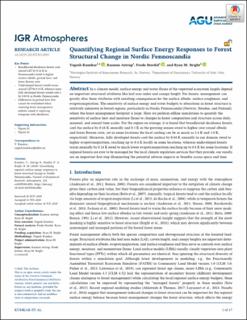Quantifying regional surface energy responses to forest structural change in Nordic Fennoscandia
| dc.contributor.author | Kumkar, Yogesh | |
| dc.contributor.author | Astrup, Rasmus Andreas | |
| dc.contributor.author | Stordal, Frode | |
| dc.contributor.author | Bright, Ryan M. | |
| dc.date.accessioned | 2021-01-26T15:23:50Z | |
| dc.date.available | 2021-01-26T15:23:50Z | |
| dc.date.created | 2020-07-27T14:57:36Z | |
| dc.date.issued | 2020-07-16 | |
| dc.identifier.citation | Journal of Geophysical Research (JGR): Atmospheres. 2020, 125 (15), . | en_US |
| dc.identifier.issn | 2169-897X | |
| dc.identifier.uri | https://hdl.handle.net/11250/2724839 | |
| dc.description.abstract | In a climate model, surface energy and water fluxes of the vegetated ecosystem largely depend on important structural attributes like leaf area index and canopy height. For forests, management can greatly alter these attributes with resulting consequences for the surface albedo, surface roughness, and evapotranspiration. The sensitivity of surface energy and water budgets to alterations in forest structure is relatively unknown in boreal regions, particularly in Nordic Fennoscandia (Norway, Sweden, and Finland), where the forest management footprint is large. Here we perform offline simulations to quantify the sensitivity of surface heat and moisture fluxes to changes in forest composition and structure across daily, seasonal, and annual time scales. For the region on average, it is found that broadleaved deciduous forests cool the surface by 0.16 K annually and 0.3 K in the growing season owed to higher year‐round albedo and lower Bowen ratio, yet in some locations the local cooling can be as much as 2.4 K and 3.0 K, respectively. Moreover, fully developed forests cool the surface by 0.04 K annually in our domain owed to higher evapotranspiration, reaching up to 0.4 K locally in some locations, whereas undeveloped forests warm annually by 0.14 K owed to much lower evapotranspiration reaching up to 0.8 K for some locations. If regional forests are ever to be managed for the local climate regulation services that they provide, our results are an important first step illuminating the potential adverse impacts or benefits across space and time. | en_US |
| dc.language.iso | eng | en_US |
| dc.publisher | John Wiley & Sons Ltd. | en_US |
| dc.rights | Attribution-NonCommercial-NoDerivatives 4.0 Internasjonal | * |
| dc.rights.uri | http://creativecommons.org/licenses/by-nc-nd/4.0/deed.no | * |
| dc.title | Quantifying regional surface energy responses to forest structural change in Nordic Fennoscandia | en_US |
| dc.type | Peer reviewed | en_US |
| dc.type | Journal article | en_US |
| dc.description.version | publishedVersion | en_US |
| dc.rights.holder | © 2020. The Authors. | en_US |
| dc.source.pagenumber | 17 | en_US |
| dc.source.volume | 125 | en_US |
| dc.source.journal | Journal of Geophysical Research (JGR): Atmospheres | en_US |
| dc.source.issue | 15 | en_US |
| dc.identifier.doi | 10.1029/2019JD032092 | |
| dc.identifier.cristin | 1820647 | |
| dc.relation.project | Norges forskningsråd: 294948 | en_US |
| dc.source.articlenumber | e2019JD032092 | en_US |
| cristin.ispublished | true | |
| cristin.fulltext | original | |
| cristin.qualitycode | 2 |
Tilhørende fil(er)
Denne innførselen finnes i følgende samling(er)
-
Divisjon for skog og utmark [522]
Publikasjoner knyttet til ansatte ved Divisjon for skog og utmark -
Publikasjoner fra CRIStin - NIBIO [4576]
-
Vitenskapelige artikler [1416]

